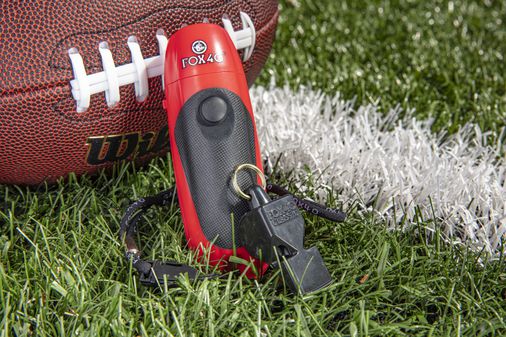A whistle is no longer just a whistle. Not in pandemic times. Going electronic is a way to limit the risk of germs being sprayed into the air, a measure to keep a lethal, highly infectious virus from spreading.
“We were lucky to be able to acquire them,” said Kevin Kavanagh, Mass Hockey’s executive director, noting that the market for the gizmos has skyrocketed in recent months. “We opened up registration for them about a week ago and have literally blown through 1,000 of them already.”
Mass Hockey bought its motherlode of new-age whistles from Tide-Rider, a wholesaler in Oakdale, Calif., some two hours east of San Francisco, that has specialized in the sports whistle niche since 1950.
According to Tide-Rider owner Dave Smith, sales of traditional whistles, the lifeblood of the company, plummeted to nearly zero in March and April. Whistle demand today is voracious, he said, but almost exclusively for electronic models.
“Due to the possibility of the droplets, which does happen with mouth-blown whistles, there’s no way around it,” said Smith. “There are a lot of people and institutions saying no to mouth-blown whistles. So you’ve got to have either an air horn or an electronic whistle — something other than releasing droplets into the air.”

Locally, Matt Gaitane, for decades a high school and college sports official who lives in Wareham, estimates some 50 percent of his fellow officials already have switched to electronic. The other 50 percent, he suspects, simply haven’t been able to acquire them.
“Tough to find,” said Gaitane. “They’re really not that available … vendors can’t keep up because the demand is so high.”
How about the air horn alternative?
“Yeah, right, I’ve heard that suggested,” he said. “Forget it. I mean, come on, a few blasts of that and you’re deaf, right?”
Both Kavanagh and Gaitane explained that under the ruling from the State House, which charged the state’s executive office of Energy and Environmental Affairs (EEA) to work out return-to-play regulations, use of electronic whistles has not been mandated. However, officials and coaches must wear face coverings.
“If you have to blow a whistle,” noted Kavanagh, “try doing that through a mask.”
We all know how to whistle, don’t we? You just put your lips together and blow. Not anymore on our fields of play. The electronic whistles are the haves, the old whistles are the have nots.
For those officials and coaches yet to go electronic, Gaitane explained, the only practical alternative will be to slip the traditional whistle under the mask and blow, ideally trapping droplets behind the mask. It will be cumbersome and add time to the process. Eventually, Gaitane believes, all officials will go electronic.
“For the foreseeable future, I think this is what you’ll see,” he said. “I think until there’s a proven vaccine, I think it’s going to be difficult getting back to normal. So a couple of years at least, yes. This thing is not going away … the world’s changing and I just hope we can get back to normal.”
Here in Massachusetts, the start of high school football season has been bumped ahead to February in deference to the pandemic. But by early October, most schools will have their soccer, field hockey, cross-country, and golf teams in full action. Look for all coaches and officials to be wearing masks, and in many cases, electronic whistles to be state of the art.
Hockey coaches in Massachusetts, explained Kavanagh, must always wear their face coverings, and the same for players when they are on the bench. On the ice, officials also must cover nose and mouth, while players only must wear the protection for faceoffs. In those instances, only the two players taking the draw are mandated to wear them.
“Not the easiest thing to navigate, but kids are figuring out how to do it,” said Kavanagh. “Again, not ideal, but it’s certainly better than being home.”
In Oakdale, Smith figures sales of electronic whistles may save the business his grandfather founded 70 years ago. COVID-19 crushed sales through spring and into the summer. Now, with orders from around the US and into Central America, the phone has been ringing constantly.
“It’s greatly increased our chances to survive this thing as a business,” he said.
Mass Hockey has been Tide-Rider’s biggest order to date, with 1,750 ordered as of Friday afternoon. Overall, demand from the hockey market has been the hottest. The Michigan Amateur Hockey Association has been considering an order for up to 2,000 units.
“We’ve been able to give them our remaining stock, which was 450 pieces, and that went out the other day,” said Smith, who buys from a Taiwan-based manufacturer. “We’ll see if they need another 1,500 when our container comes in at the end of the month.”

Tide Rider
Wait, Michigan with more electronic whistles than Massachusetts?
“Absolutey not!” said an amused Smith, buying easily into a rivalry that goes back to leather skates, wood sticks, and mouth-blown whistles. “I’ll try to keep ’em down to 1,749.”
Kevin Paul Dupont can be reached at [email protected]. Follow him on Twitter @GlobeKPD.


